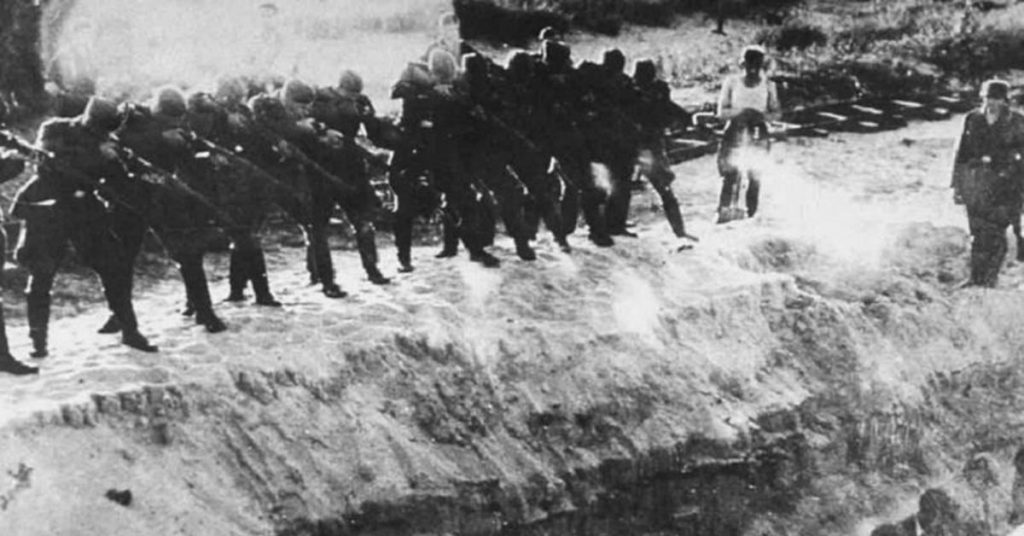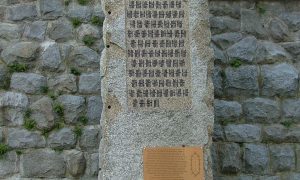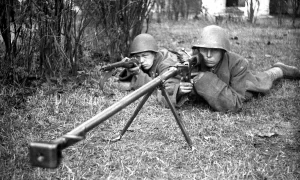During the Great Patriotic War, German troops, who occupied Kiev on September 19, 1941, used Babi Yar as a place of mass executions.

Babi Yar Massacre
According to some sources, in Babi Yar about one hundred and fifty thousand people (residents of Kiev and other cities of Ukraine) were shot. 29 people were saved from Babi Yar.
Babi Yar is in the northwestern part of Kiev, between the districts of Lukyanovka and Syrets. Babi Yar gained worldwide fame as the site of mass executions of civilians by the Nazis and Ukrainian collaborators, mainly of Jews, Roma, and Soviet prisoners of war, and carried out by the German occupation forces during the Second World War.
There are several monuments on the territory of Babi Yar, both to the victims of the Holocaust and to other Soviet citizens. Before the Kurenyov tragedy of 1961, there was one of the largest ravines in Kiev – about 2.5 km long, over 50 m deep. A stream of the same name flowed along its bottom, which is now taken into a collector.
History
Before the Great Patriotic War
It was first mentioned under its modern name in 1401, when the owner of the tavern (in Ukrainian “baba”), which was located here, sold these lands to a Dominican monastery. In the 15th-18th centuries, the names “Shalena Baba” and “Bisova Baba” were also encountered.
In 1869, a summer military camp was opened near Babi Yar – “Syretsk military camp”. In 1895, the Divisional Church was opened on its territory, destroyed after the Bolshevik revolution. On the site of this church, there were later the gates of the Syrets concentration camp.
In 1870, the territory adjacent to Babi Yar from the south was used for the construction of the Lukyanovskoye civil cemetery (there is also the Lukyanovskoye military cemetery ). The cemetery was closed in 1962. Currently, the territory of the cemetery is a conservation area.
In 1891-1894, in the immediate vicinity of Babi Yar, a New Jewish cemetery (with a plot for the Karaites ) was created. It was closed in 1937 and destroyed during World War II. Only a small fragment of the cemetery and office has survived. The remaining burials were transferred in the 1960s to Baikovoye (section 49) and Berkovetskoye cemetery.
Since 1996 (for the first time in the publication of Holocaust denier T. Tur), there are claims that victims of the 1932-1933 famine and repression were buried on the territory of Babi Yar. As studies by T. Evstafyeva and V. Nakhmanovich show, those who died of starvation were buried at the nearby former Bratsk cemetery, and the repressed at the Lukyanovskoye cemetery and in Bykovna.
During the Great Patriotic War
During the Great Patriotic War, German troops, who occupied Kiev on September 19, 1941, used Babi Yar as a place of mass executions.
The first execution took place on September 27, 1941 – 752 patients of the V.I. Ivan Pavlov, which was in close proximity to the ravine. The exact place of the execution is unknown.
On September 24, on Khreshchatyk, houses were blown up, in which representatives of the occupation administration were located. Explosions and fires continued in the following days, with about 940 large residential and office buildings destroyed. In the report of the representative of the imperial ministry of the occupied eastern regions of October 5, 1941, it was said that the fire spread over an area of 200 thousand square meters. About 50 thousand people were left homeless.
Babi Yar, analysis of the belongings of the deceased. Black and white copy of a color photograph by J. Hele
… Dina rushed about, ready to run, but there was noise and crying. An officer came, leading two girls, fifteen or sixteen years old. The girls screamed, sobbed, threw themselves on the ground and tried to kiss the officer’s boots, begged to force them to do whatever they wanted, just not shoot them. They were in the same neat dark dresses, with pigtails. – We’re from an orphanage! They shouted. – We do not know who we are by nationality. We were brought in as nurses! – The officer watched them roll around and moved his legs. I told them and Dinah to follow him. We went out to the same square where they were undressed. There were still heaps of clothes and shoes. Behind the things, on the sidelines, were thirty or forty old men, old women and the sick. That’s right, these were the remains, caught in the apartments. One old woman lay paralyzed, wrapped in a blanket. Dina and the girls were seated with them. The girls were crying softly…
Babi Yar. Novel document (excerpt)
At the end of September 1941, the Sonderkommando captured nine leading rabbis of Kiev and ordered them to make an appeal: “After sanitation, all Jews and their children, as a nation, will be transported to safe places…” On September 27-28, the Nazi authorities issued an order that on September 29 the Jewish population of the city should appear at the designated collection point by 8 a.m. with documents and valuables. For non-observance of the order, they were supposed to be shot. About 2 thousand ads were posted around the city. At the same time, misinformation about the intention to conduct a census and resettlement of Jews was spread through the janitors and house managers. Most of those who came were women, children and old people (the adult male population was drafted into the army), in addition to Jews, there were representatives of other nationalities from international families.

At the end of the street, a checkpoint was set up, behind which there was an office hidden from the side. In turn, 30-40 people were taken outside the checkpoint, where their belongings were taken away and forced to undress. Then the policemen, with the help of sticks, drove people into the passages in the embankment at the edge of the ravine 20-25 meters deep. On the opposite edge was a machine gunner. After the ditch was filled with 2-3 layers of corpses, they were sprinkled with earth on top.
I stopped nearby, and the Ukrainians who were in the clearing began to load the car with things. From this place I saw that the arriving Jews – men, women and children – were also met by Ukrainians and directed to the place where they had to take turns to put their belongings, coats, shoes, outerwear and even underwear. In a certain place, the Jews had to put their jewelry as well. All this happened very quickly: if someone was delayed, the Ukrainians urged him on with kicks and blows. I think that not even a minute passed from the moment when the man took off his coat, until he was already completely naked. No distinction was made between men, women and children… The undressed Jews were sent into a ravine about 150 meters long, 30 meters wide and as much as 15 meters deep. There were 2 or 3 narrow passages leading into this ravine,on which the Jews descended. When they approached the edge of the ravine, the German police grabbed them and laid them on the corpses of the Jews who had already been shot there. This happened very quickly. The bodies lay in neat rows. As soon as the Jew lay down, a German policeman came up with a submachine gun and shot the man in the back of the head. The Jews descending into the ravine were so frightened by this terrible picture that they became completely weak-willed… It was a conveyor belt that did not distinguish between men, women and children. The children were left with their mothers and were shot together with them… In the pit I saw corpses lying three rows wide, each about 60 meters. How many layers lay one on top of the other, I could not make out. The sight of the bodies twitching in convulsions, covered with blood simply did not fit into my consciousness, so the details did not reach me… While some people were undressing,and the majority were waiting for their turn, there was a lot of noise.
The Ukrainians paid no attention to him. They continued in haste to drive people through the passages into the ravine. From the place where the undressing took place, the ravine was not visible, since it was at a distance of about 150 meters from the first group of clothes. In addition, there was a strong wind and it was very cold.
No shots were heard in the ravine… More and more people were arriving from the city and they, apparently, did not suspect anything, believing that they were simply being resettled.
From the testimony of the Wehrmacht driver Hefer
Since it was not possible to shoot all the arrivals in one day, the premises of military garages were used as a temporary detention center for those who arrived at night.
The surviving color photographs of J. Hele, taken shortly after the executions, did not make it possible to accurately identify the place, since the relief of the ravine changed greatly in the post-war period, especially after the Kurenevsky landslide of the 1960s. Nevertheless, a study carried out in 2020-2021 made it possible to compare photographs with aerial photographs of the same time and accurately localize all the places of events. .
For two days, 29 and 30 September 1941, Sonderkommando 4a under the command of Standartenfuehrer Paul Blobel (which was part of Einsatzgroup C under the command of SS Brigadefuehrer and Police Major General Otto Rasch ) with the participation of 45 and 303 battalions of the German police of the order of the police regiment South ”and the Ukrainian auxiliary police shot 33,771 people in this ravine (this number does not include young children under 3 years old, who were also killed on these two days). Sonderkommando 4a and the 45th battalion of the German police of order took a direct part in the executions. Servicemen of the 303rd battalion of the German police of order stood in a cordon around the places of execution. The shootings did not stop there. Further executions of Jews took place on October 1 and 2, October 8 and October 11, 1941.
Russian husbands saw off their Jewish wives. Russian wives saw off their Jewish husbands. Approaching Babi Yar, we heard shooting and inhuman screams. I began to understand what was happening here, but I didn’t say anything to my mother… When we entered the gate, we were ordered to hand over documents and valuables and undress. One German approached his mother and tore off a gold ring from her finger. I saw women, old men and children undressing group after group. Everyone is brought to an open pit, and the machine gunners shoot them. Then another group is brought in… I saw this horror with my own eyes. Although I was not quite close to the pit, I still heard the eerie cries of distraught people and the muffled voices of children calling: “Mom, mom…”.
Testimony of Dina Pronicheva, Babi Yar survivor
The lack of housing, especially in Kiev, as a result of extensive fires and explosions, was palpable, but after cleansing of Jews it was eliminated thanks to moving into vacated apartments… On September 29 and 30, 31,771 Jews were specially treated…
Heinrich Müller. Report No. 6, dated October 31, 1941
Mass executions continued until the Germans left Kiev. On January 10, 1942, about 100 sailors of the Dnieper detachment of the Pinsk military flotilla were shot. Babi Yar became the place of execution of five gypsy camps.
According to various estimates, in Babi Yar in the period from 1941 to 1943, from 70,000 to 200,000 people were shot. Jewish prisoners, whom the Nazis forced to burn their bodies in 1943, spoke of 70-120 thousand.
In February – March 1942, 621 members of the Organization of Ukrainian Nationalists ( supporters of Andrey Melnyk ) and the poet Elena Teliga with colleagues from the newspaper “Ukrainian Word” were shot there. Historian and educator Ilya Levitas believes that they were killed in the dungeons of the Gestapo on Vladimirskaya Street.
In addition, on the site of the military camp of the Red Army units (the former military camp of the Russian Imperial Army ), the Syrets concentration camp was opened, which contained communists, Komsomol members, underground workers, prisoners of war and others. On February 18, 1943, three players of the Dynamo football team, participants in the so-called Death Match, were shot there : Trusevich, Kuzmenko and Klimenko (it was later confirmed that their deaths were not related to the game, but the legend in Death Match was composed to divert attention from the Jewish aspect of the Babi Yar tragedy. In total, at least 25,000 people died in the Syrets concentration camp.
An experimental soap factory was created in Babi Yar to produce soap from the dead, but the Germans did not manage to finish building it. Retreating from Kiev and trying to hide the traces of the crimes, the Nazis in August – September 1943 partially destroyed the camp, dug up and burned tens of thousands of corpses in open “ovens”, the bones were ground in cars brought from Germany, the ashes were scattered around Babi Yar. On the night of September 29, 1943, an uprising of 329 death row inmates working at the furnaces took place in Babi Yar, of whom 18 people were saved, the remaining 311 were shot. The surviving prisoners witnessed the Nazis’ attempts to hide the fact of the mass execution.

Executors of executions
The Einsatzgruppen Case established that the executions on September 29 and 30, 1941 in Babi Yar were carried out by Sonderkommando 4a of the Eiznatzgruppa C under the leadership of SS Standartenfuehrer Paul Blobel with the support of the 45th and 303rd battalions of the German police (German Polizei-Bataillon) of the order of the police regiment “South”. These units were reinforced by units of the auxiliary police of Ukraine and supported by local collaborators.
In the journalistic articles of various authors, one can find non-documented information about the participation of Ukrainian nationalists in the executions, in particular, the Bukovyna kuren (which was not in Kiev at that time). According to the testimony of Paul Blobel during the tribunal and after confirming 106 of the Einsatzgruppen report, the Ukrainian militia (police) posted an advertisement in Kiev. In addition, the Germans in the occupied territories armed the Ukrainian auxiliary police with a very limited number of rifles and cartridges for them, not including the machine guns from which the executions were carried out in Babi Yar.
Trials of the guilty
Major General Kurt Eberhard, who gave the order for the execution, was not convicted – he committed suicide in 1947 in Stuttgart. Head of the Sonderkommando «4a» Paul Blobel was sentenced in 1948 to death by hanging and executed in 1951 in Landsberg prison. Kiev Police Commandant Andrey Orlik (real name Anatoly Konkel) was fired from the police shortly after the September executions. At the end of the war, under the name Anatoly Orlik, he served in the SS “Galicia” division with the rank of centurion, was captured by the Western allies and was in a camp in Rimini (Italy). Subsequently, like many other divisional men from the camp in Rimini, Anatoly Konkel left for Great Britain, where he lived under the name Anatoly Orlik and died in Birmingham in May 1989, at the age of ninety.
The General Commissioner of Kiev Helmut Kwitzrau was not brought to justice, he died in 1999.
Otto Rasch, the head of the Einsatzgruppen C under whose leadership the massacres of Jews at Babi Yar were carried out, was arrested after the war and charged as a defendant in the Einsatzgruppen case. The case against Rush was dropped due to Parkinson’s disease.
From 1967 to 1968, former employees of the Sonderkommando 4a were tried at the Darmstadt Regional Court. The main defendant, Kuno Kallsen, was sentenced to 15 years in prison, Kurt Hans and Adolf Janssen to 11 years, August Hefner to 9 years, Victor Voiton to 7 years, Christian Schulte to 4 years and 6 months in prison, Alexander Riesle to 4 years in prison. Georg Pfarrkircher, Ernst Konzee and Viktor Trill were released under §47 of the German Penal Code.
Former SS Sturmbannfuehrer and commander of the 45th Police Battalion Martin Besser was not prosecuted for health reasons.













